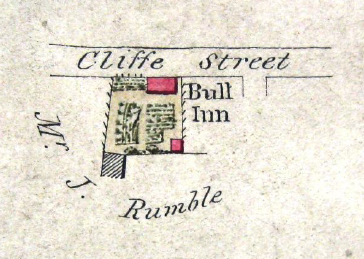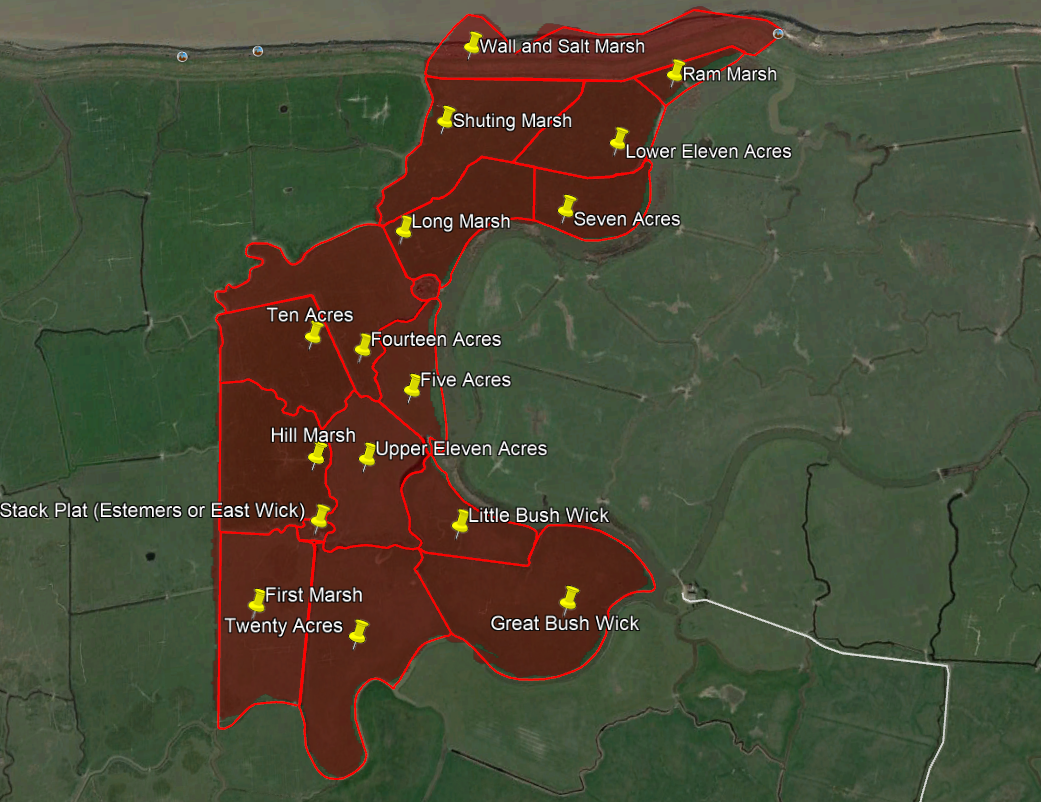The Manor of Prior's Hall
Sadly, due to either guesswork or limited research, a privately published history of Cliffe places Prior’s Hall at the old rectory on the southern edge of the village: this error has been mirrored in subsequent publications that have recorded the history of Cliffe.
The location of the Manor of Prior’s Hall lay in the centre of Cliffe Village, close to the parish church: today the site would be between the former Black Bull pub and Longford House.

Extract from the Manorial Map of Prior's Hall showing the site of The Manor House marked in red.
The Prior’s Hall Manor, together with Berrycourt and Mallingden, is one of the oldest known manors in the parish of Cliffe, dating back to the era of Anglo-Saxon rule.
It was in 1069 when Archbishop Lanfranc decided to partitioned the lands leaving Christchurch with all bar Prior’s Hall for the benefit of the monks of Christchurch for their subsistence, clothing, and other necessary uses. Prior’s Hall he retained, as part of the revenues of the see of Canterbury, for the use of himself and his successors.
The other lands and estates that were not requisitioned by Archbishop Lanfranc were granted to Odo, Bishop of Bayeux, by his brother William the Conqueror. Recorded in the Domesday Book it stated that Ernulf de Hesding holds Cliffe for the Bishop of Bayeux.
Some four years later, after the disgrace of Bishop Odo for defrauding, not only Lanfranc, but also the Crown and his subsequent three-day tribunal, known as the Trial of Penenden Heath, his lands in Cliffe, which now included the manors of Mortimer’s and Cardon’s, were seized by the Crown.
The great land swap of 1195.
In the year 1195, with the King Richard I's consent, and for the mutual benefit of the churches of Canterbury and Rochester, exchanged, among other premises, a sheepcote in Cliffe, which was called Estmers, with two hundred and twenty sheep, and certain land in Cliffe, belonging to it, and certain tenants in this parish, with the lands which they held, and the rents, services, and customs, without any reservation to the Archbishop and his successors, for the manor of Lambeth (where Lambeth Palace in now situated), with the monks of St. Andrew's, in Rochester.
The Priory of St. Andrew's continued in possession of these premises and the manor belonging to them, called Prior's Hall, till the time of its dissolution in 1541. King Henry held it for less than a year before he donated it to his newly formed Dean and Chapter of Rochester.
The manor house itself had fallen into disrepair for, in 1577, there was a major rebuild of Prior’s Hall manor house itself. The documents pertaining to the rebuilding of Prior's Hall lay in the Medway Archives but are in such poor condition that they cannot be viewed. It is such a shame as the following years entries are in excellent condition.

Map showing the land held by the Manor of Prior's Hall
The Manor and lands were leased out to various people over the years with notable lessees being: Richard Browne and his descendants, Thomas Lampugh, Archdeacon of Richmond, Yorkshire, Edward Twopenny James Roper Head and The Port of London Authority.
A disastrous fire in Church Street in 1901, in which four lives were lost brought home to the Parish in general and the Parish Council in particular, the need for fire-fighting service in the village and by 1904, the first fire engine – a horse-drawn manual-30ft. wheeled escape and other necessary equipment, were in the newly erected Fire Station. The site of the manor house of Prior’s Hall was considered but another site was chosen. It was thought that the manor house was no longer in existence, a possible victim of the fire that consumed the abutting Black Bull pub in 1886/7, but a building on the site can be clearly be seen, on some early 20th Century postcards, next to the rebuilt Black Bull pub.
The estate continued to remain in the ownership of the Dean and Chapter
of Rochester as can be seen on the Tithe Map of 1840. The last of the lands belonging to the Manor of Prior’s Hall were purchased by the Port of London Authority in 1969 in the anticipation that the area would be chosen for a major port development: it never happened and a container port was built on the opposite bank of the Thames.
